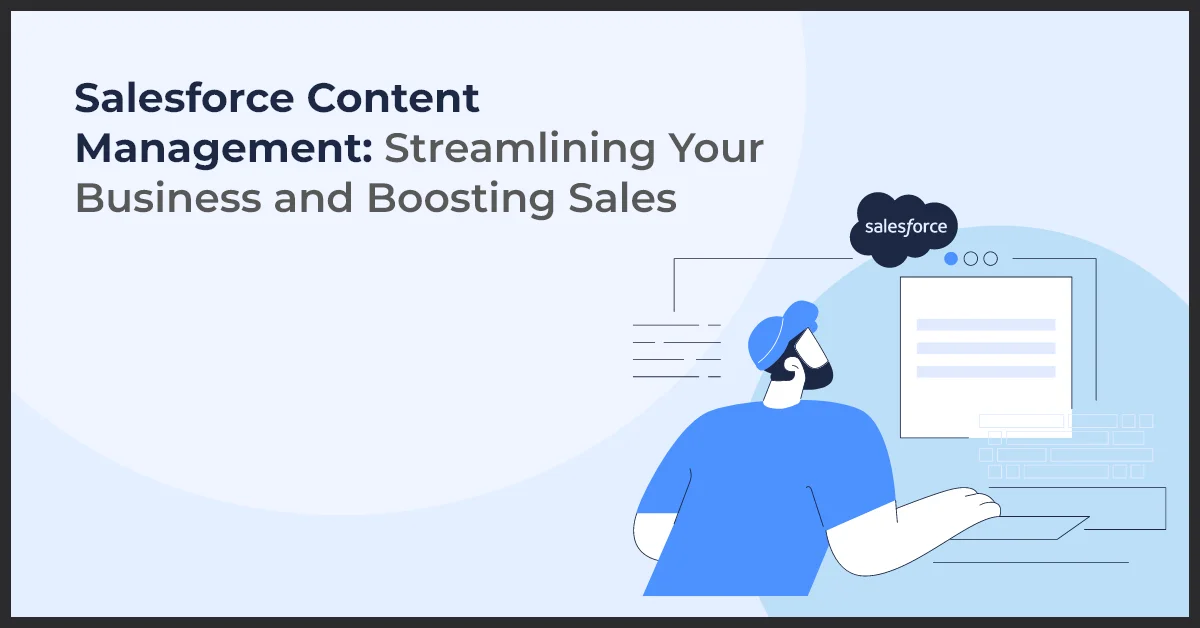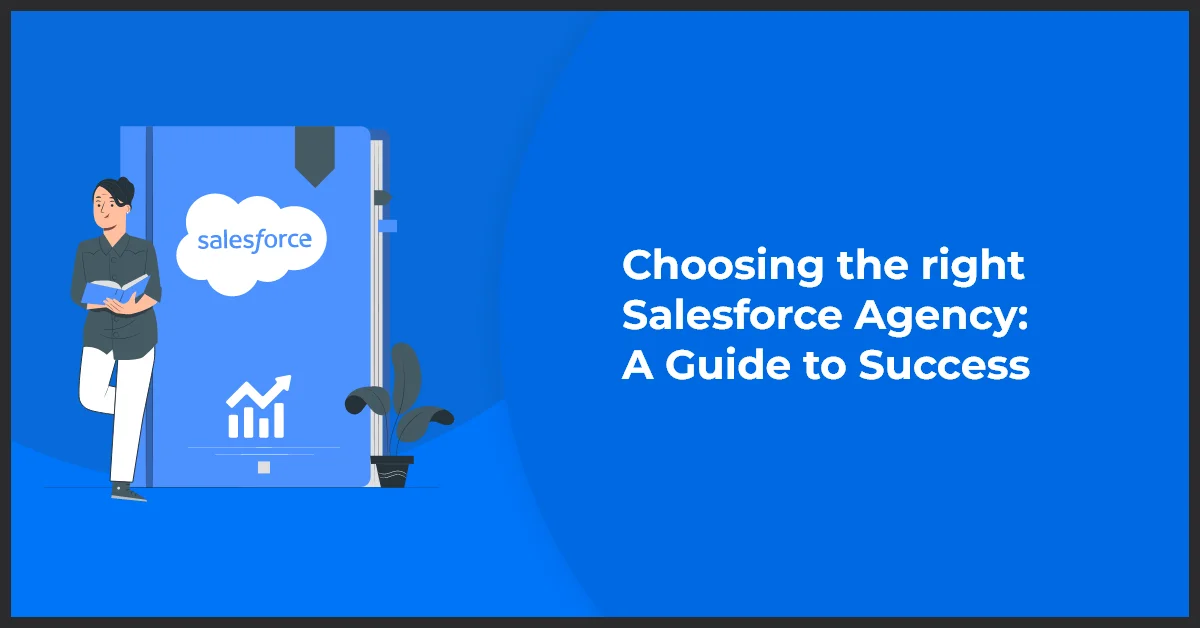Salesforce Content Management: Streamlining Your Business and Boosting Sales

Published on: November 6, 2023
Updated on: April 17, 2024
1889 Views
- Salesforce
21 min read
The ability to efficiently manage and organize content is crucial for driving growth and maximizing sales and Salesforce Content Management comes in handy when you are pursuing this endeavor.
Salesforce Content Management refers to utilizing Salesforce's comprehensive suite of tools and features to enhance content management capabilities within your organization. By seamlessly integrating with Salesforce's powerful CRM platform, businesses can effectively streamline their content strategy, increase productivity, and ultimately drive revenue.
One of the key ways that Salesforce enhances content management capabilities is through its intuitive and user-friendly interface. The platform provides easy access and centralized control over all types of content, including documents, images, videos, and more.
This allows teams to collaborate more efficiently, ensuring that the most up-to-date and impactful content is readily available to sales representatives, improving their efficiency and effectiveness in engaging with prospects and closing deals.
There are numerous benefits to using Salesforce for content management.
- It allows businesses to create and manage personalized, targeted content that resonates with their audience, improving customer engagement and conversion rates.
- Salesforce's advanced analytics and reporting capabilities provide valuable insights into content performance, enabling businesses to optimize their strategies and make data-driven decisions.
- Salesforce Content Management enables seamless integration with other tools, such as customer relationship management, marketing automation, and customer service. This integration empowers businesses to deliver a consistent and unified customer experience across all touchpoints, fostering customer loyalty and increasing brand advocacy.
Understanding Salesforce and its Features
Regarding content management, Salesforce offers a comprehensive CRM platform with a range of features designed to meet the specific needs of businesses. Let's take a closer look at what Salesforce has to offer:
Overview of Salesforce as a CRM Platform
Salesforce is widely recognized as the leading CRM platform, enabling businesses to manage customer data and interactions effectively. With its user-friendly interface and powerful capabilities, Salesforce has become an indispensable tool for sales, marketing, and customer service teams.
Key features relevant to content management
Within Salesforce, there are vital features that are particularly relevant to content management:
- Customizable Content Fields: Salesforce allows you to create custom fields to capture and organize content-related data, such as document types, versions, tags, etc.
- Content Versioning: With Salesforce, you can easily track and manage different versions of your content. This ensures that the most up-to-date information is always available to your team.
- Content Collaboration: Salesforce provides collaboration tools that enable teams to work together on content creation, editing, and review processes. This helps to streamline content development and improve productivity.
- Content Analytics: Salesforce offers robust analytics and reporting capabilities, allowing you to gain insights into how your content is performing. You can track views, engagement, and conversions to optimize your content strategy.
Integrating CRM and content management through Salesforce
One of the unique advantages of Salesforce is its ability to integrate CRM and content management seamlessly. By connecting your CRM data with your content assets, you can gain a holistic view of your customers and tailor your content to their needs and preferences. This integration leads to more personalized and targeted content, improving customer engagement and satisfaction.
Salesforce as a Content Management System (CMS)
Salesforce is not only a robust customer relationship management (CRM) platform, but it also offers robust content management system (CMS) capabilities. This makes it an ideal choice for businesses looking to streamline their content management processes.
Explaining Salesforce's CMS capabilities
With Salesforce CMS, businesses can easily create, manage, and distribute content across multiple channels. The CMS allows for creating web pages, articles, and blogs, making it a versatile platform for content creation.
One of the key features of Salesforce CMS is its ability to store content in a structured manner. This ensures that content is easily searchable and organized into categories, making it easier for users to find the necessary information.
Differentiating Salesforce CMS from other CMS platforms
Unlike traditional CMS platforms, Salesforce CMS is deeply integrated with the Salesforce CRM. This means that businesses can leverage their existing customer data to personalize content and deliver a more tailored experience to their customers.
Additionally, Salesforce CMS offers seamless integration with other products, such as Salesforce Marketing Cloud and Salesforce Sales Cloud. This allows businesses to align their sales and marketing efforts with their content management strategy, resulting in a more cohesive and effective approach.
Benefits of Using Salesforce as a CMS
- Unified platform: Salesforce as a CMS offers a suitable platform for businesses to manage customer data and content, eliminating the need for multiple systems and improving efficiency.
- Personalization: With Salesforce CMS, businesses can leverage customer data to create personalized content and deliver a more relevant experience to their audience.
- Seamless integration: Salesforce CMS integrates seamlessly with other products, allowing businesses to align their content management strategy with their overall sales and marketing efforts.
- Improved collaboration: Salesforce CMS enables team collaboration, making it easier for multiple stakeholders to contribute to and manage content.
- Scalability: As a cloud-based CMS, Salesforce offers scalability, allowing businesses to expand their content management capabilities as their needs grow.
Leveraging Cloud for Content Management
Cloud-based content management has changed how businesses handle their information and collaborate across teams. Salesforce offers an array of robust cloud solutions that not only simplify content management but also enhance productivity and efficiency.
Advantages of Cloud-based Content Management
- Flexibility: Cloud-based content management allows seamless access to information anywhere and anytime. This flexibility enables sales teams to be more agile and responsive to customer needs, improving customer satisfaction.
- Scalability: With Salesforce's Cloud offerings, businesses can quickly scale their content management infrastructure as their needs grow. This eliminates the need for costly hardware upgrades and provides a cost-effective solution for businesses of all sizes.
- Collaboration: Cloud-based content management fosters collaboration among team members by providing a centralized platform for sharing and editing documents. This eliminates silos and improves communication, resulting in increased productivity.
- Data Security: Salesforce's Cloud ensures the security of sensitive business data by employing advanced encryption techniques and regular backups. This protects against data breaches and guarantees the integrity of your content.
Salesforce's Cloud Offerings and its Significance in Content Management
Salesforce offers a comprehensive range of Cloud solutions specifically designed to meet the content management needs of businesses:
- Salesforce Sales Cloud: This Cloud offering empowers sales teams to manage their content throughout the sales cycle efficiently. From prospecting to closing deals, Sales Cloud enables seamless content accessibility and tailored content delivery.
- Salesforce Service Cloud: Service Cloud helps customer service teams provide personalized and relevant content to their customers. It enables easy access to product support materials, FAQs, and tutorials, enhancing customer satisfaction.
- Salesforce Community Cloud: Community Cloud facilitates collaboration and knowledge sharing among employees, partners, and customers. It allows the creation of custom communities where content can be shared, discussed, and improved collaboratively.
How Salesforce Cloud Enables Seamless Content Accessibility
Salesforce Cloud ensures that content is accessible to people at the right time. By storing content in the Cloud, businesses can eliminate the need for manual file transfers and enable real-time access to information. This improves efficiency, reduces delays, and helps teams to make data-driven decisions.
Furthermore, Salesforce Cloud's intuitive interface and powerful search capabilities enable users to find and retrieve specific content quickly, eliminating the frustration of navigating complex folder structures.
Managing Content through the Salesforce App and Site
Managing content effectively is crucial for organizations to drive engagement and achieve business objectives. Salesforce offers robust app and site management features that empower businesses to create, organize, and update content seamlessly.
Overview of Salesforce's App and Site Management Features
Salesforce provides a user-friendly interface for managing web and mobile applications, allowing businesses to have a cohesive content management strategy across multiple channels. The app and site management features enable businesses to:
- Create and manage custom pages and layouts.
- Import and export content easily
- Track and analyze the app and site performance.
- Set up personalized user experiences.
- Implement responsive designs for optimal viewing across devices.
How to Create, Organize, and Update Content Within Salesforce
Salesforce simplifies content creation by offering a variety of tools and functionalities. Businesses can:
- Create and edit content directly within Salesforce.
- Organize content using folders, tags, and categories.
- Collaborate with teams by assigning roles and permissions.
- Manage content versions and revisions.
- Integrate content from external sources.
Updating content within Salesforce is a seamless process. Businesses can make real-time updates to keep their content fresh and relevant, ensuring that customers always have access to the latest information.
Optimizing Content Management Workflows Using the Salesforce App and Site
Salesforce's app and site management capabilities streamline content management workflows, increasing efficiency and productivity. Businesses can:
- Automate content publishing and distribution
- Implement approval processes for content updates
- Track content performance and engagement metrics
- Integrate with other Salesforce features for seamless data management
By leveraging the power of Salesforce, organizations can optimize their content management workflows and deliver exceptional digital experiences to their customers.
Enhancing Customer Experience through Salesforce Content Management
- Role of content in improving customer interactions: Content enhances customer interactions by providing valuable information and engaging experiences. With Salesforce Content Management, businesses can leverage the power of content to create meaningful connections with their customers.
- Using Salesforce to deliver personalized and relevant content: Salesforce Content Management enables businesses to provide personalized and relevant content to their customers. By leveraging customer data and insights, businesses can understand their preferences and tailor content to their needs and interests.
- Leveraging Salesforce Content Management for Better Customer Engagement: With Salesforce Content Management, businesses can enhance customer engagement by delivering content through various channels and touchpoints. Whether through emails, websites, or mobile applications, businesses can ensure that their content reaches their customers at the right time and in the correct format.
Streamlining Information with Salesforce Content Management
Streamlining and organizing information is crucial for effective content management. With Salesforce Content Management, businesses can ensure that information is easily accessible and efficiently managed.
Importance of Organizing and Categorizing Content Effectively
When information is scattered and disorganized, it becomes difficult to find what you need when you need it. Salesforce Content Management allows you to organize and categorize your content, making it easier to navigate and search for specific information. By managing your content effectively, you can save time and improve productivity.
Utilizing Salesforce's Information Management Capabilities
Salesforce provides robust information management capabilities that help businesses streamline their content. With features like metadata tagging, version control, and content workflows, Salesforce Content Management enables businesses to keep their information up-to-date, accurate, and easily accessible by the right people.
Best Practices for Maintaining a Centralized Repository of Content
One of the critical advantages of Salesforce Content Management is the ability to maintain a centralized repository of content. To ensure the efficiency of your content management system, it is essential to follow best practices such as creating a clear folder structure, using consistent naming conventions, implementing permissions and access controls, and regularly auditing and archiving outdated content.
Ensuring Document Security and Compliance in Salesforce
Regarding managing your content, security, and compliance should always be top priorities. Salesforce Content Management offers a range of robust security features to protect your documents and ensure regulatory compliance.
Discussing the Security Features of Salesforce Content Management
Salesforce understands the importance of keeping your documents secure. With built-in security features such as encryption, access controls, and user authentication, you can have peace of mind knowing that your sensitive data is protected.
Encryption ensures that your documents are stored and transmitted securely, safeguarding them from unauthorized access. Access controls allow you to set permissions for different users, providing that only authorized individuals can view, edit, or share specific documents.
User authentication, including multi-factor authentication, adds an extra layer of security by verifying the identity of users before granting them access to your content. This helps prevent unauthorized users from accessing sensitive information.
How Salesforce Protects Sensitive Data and Ensures Compliance
Salesforce complies with various data privacy and protection regulations, ensuring that your content management practices align with industry standards. Through regular audits and certifications, Salesforce maintains a high level of compliance with regulations such as GDPR, HIPAA, and ISO 27001.
To further protect sensitive data, Salesforce offers features like data loss prevention (DLP) and event monitoring. DLP helps prevent data leaks and unauthorized sharing of documents by monitoring and enforcing policies on document access and sharing.
Event monitoring allows you to track and analyze user activities within Salesforce, providing visibility into who is accessing, modifying, or sharing your documents. This helps identify potential security breaches and ensures compliance with data privacy regulations.
Recommendations for Maintaining a Secure Document Environment
To maintain a secure document environment in Salesforce Content Management, consider implementing the following best practices:
- Regularly review and update access controls to ensure that only authorized users have access to sensitive documents.
- Train employees on data security and privacy practices to minimize the risk of accidental data breaches.
- Enable encryption for all documents stored in Salesforce to protect them from unauthorized access.
- Implement strict password policies and consider using multi-factor authentication to enhance user authentication.
- Regularly monitor user activities and document logs to detect suspicious behavior or security threats.
- Stay informed about the latest data privacy regulations and ensure your content management practices comply.
Following these recommendations, you can create a secure document environment in Salesforce Content Management, safeguarding sensitive data and ensuring compliance with regulatory requirements.
Aligning Sales and Marketing with Salesforce Content Management
For any business, effective collaboration between the sales and marketing teams is crucial to drive growth and success. However, it is expected to encounter challenges and gaps in communication between these departments. Salesforce Content Management offers a powerful solution to bridge this gap and align sales and marketing efforts.
Exploring Strategies to Bridge the Gap Between Sales and Marketing Teams
With Salesforce Content Management, organizations can implement strategies to foster collaboration and synergy between sales and marketing teams. By creating a centralized hub for content management, both teams can work together seamlessly, sharing ideas, insights, and resources.
How Salesforce Content Management Enables Collaboration Between Teams
Through Salesforce Content Management, the sales and marketing teams can access a shared platform to collaborate on content creation, editing, and distribution. This ensures that both teams have a unified view of the content pipeline, eliminating duplication of efforts and streamlining their workflow.
Enhancing Content Delivery to Support Sales and Marketing Alignment
Salesforce Content Management empowers sales and marketing teams to deliver targeted and consistent content throughout the customer journey. By leveraging features such as personalization, automation, and analytics, organizations can optimize content delivery to meet the specific needs of their audience and enhance alignment between sales and marketing efforts.
Optimizing Knowledge Management with Salesforce
Knowledge management is crucial in a business context as it allows organizations to capture, share, and retain valuable information effectively. With Salesforce as a powerful content management system (CMS), businesses can optimize knowledge management in various ways.
Utilizing Salesforce for Knowledge Sharing and Retention
Salesforce provides a comprehensive platform for knowledge sharing and retention. Through its robust features, employees can easily capture and document their knowledge, making it accessible across the organization. With Salesforce, businesses can create a centralized knowledge base, ensuring that critical information is readily available to employees.
Salesforce's intuitive interface allows for easy navigation and search, making it simple to find the information needed. Additionally, Salesforce's mobile capabilities enable employees to access knowledge on the go, increasing productivity and efficiency.
Strategies for Effective Knowledge Management Using Salesforce
- Create a Knowledge Management Strategy: Begin by defining goals and objectives for knowledge management within Salesforce. Determine what information needs to be captured, how it will be organized, and who will be responsible for maintaining it.
- Implement Knowledge-Sharing Tools: Leverage Salesforce's collaboration tools, such as Chatter, to encourage employee knowledge-sharing. Encourage active participation and create a culture of knowledge sharing within the organization.
- Establish Knowledge Management Processes: Define processes for capturing, documenting, and updating knowledge within Salesforce. Regularly review and correct information to ensure its accuracy and relevance.
- Provide Training and Support: Offer training sessions and resources to educate employees on effectively using Salesforce for knowledge management. Provide ongoing support to address any questions or issues that may arise.
- Measure and Improve: Continuously monitor the effectiveness of your knowledge management strategy. Utilize Salesforce's reporting and analytics capabilities to track usage, identify gaps, and make necessary improvements.
Governing Information with Salesforce Content Management
Information governance refers to the set of policies, processes, and controls that organizations implement to ensure the availability, security, and integrity of their data. It involves managing data throughout its lifecycle, from creation to disposal. It includes data quality, metadata management, and compliance with regulatory requirements.
Salesforce Content Management provides a robust platform for implementing information governance practices. With its powerful features and capabilities, Salesforce enables organizations to manage and govern their content and data effectively.
Explaining the Concept and Benefits of Information Governance
Information governance is crucial for organizations seeking to maintain data quality, ensure compliance, and make informed business decisions. By implementing information governance practices, organizations can:
- Ensure data accuracy and consistency
- Enhance data security and privacy
- Comply with regulatory requirements
- Improve efficiency and productivity
- Reduce risks associated with data breaches
- Enable better decision-making through reliable data
Implementing Information Governance Using Salesforce
Salesforce offers a range of tools and features that enable organizations to implement effective information governance practices. Some key features include:
- Data validation rules: Define rules to ensure data integrity and accuracy.
- Data security and sharing settings: Control access to sensitive information and implement security measures.
- Workflow and approval processes: Streamline data management processes and ensure data quality.
- Metadata and taxonomy management: Create and manage metadata to accurately classify and organize content.
- Retention and archiving: Set retention policies to manage the lifecycle of content and data.
Best Practices for Maintaining Data Quality and Governance in Salesforce
To maintain data quality and governance in Salesforce, organizations should consider the following best practices:
- Establish data governance policies and guidelines
- Regularly clean and validate data
- Implement data deduplication processes
- Train users on data entry and management best practices
- Regularly audit data for compliance and accuracy
- Monitor and address data quality issues promptly
Managing Digital Assets in Salesforce
Managing digital assets in Salesforce is crucial for an organized and efficient content management system. With the right tools and features, Salesforce offers a comprehensive solution for storing, managing, and sharing various digital assets.
Overview of Digital Asset Management (Dam) in Salesforce
In Salesforce, Digital Asset Management (DAM) refers to systematically managing digital files, such as images, videos, documents, and presentations. With DAM, organizations can ensure their digital assets are easily accessible, searchable, and secure.
Salesforce's Capabilities for Storing, Organizing, and Sharing Digital Assets
Salesforce provides robust capabilities for managing digital assets within its platform. Users can securely store and organize their digital assets in Salesforce's content library, ensuring easy access and centralization of all assets in one place.
The content library in Salesforce allows users to create folders and subfolders to organize their digital assets and maintain a clear structure. With powerful search functionalities, users can quickly find specific assets based on keywords, tags, or metadata.
Additionally, Salesforce enables users to share digital assets with internal teams or external stakeholders using secure file-sharing features. This ensures seamless collaboration and improved productivity throughout the content management process.
Enhancing Digital Asset Management Through Salesforce Integration
One of the critical advantages of managing digital assets in Salesforce is the ability to integrate with other Salesforce modules and applications seamlessly. Salesforce integration allows for enhanced functionality and improved efficiency in managing and utilizing digital assets.
For example, integrating Salesforce's digital asset management capabilities with the Marketing Cloud enables marketing teams to leverage these assets directly in their campaigns, ensuring brand consistency and providing a unified customer experience.
Furthermore, integrating Salesforce with third-party DAM systems can provide even more advanced features, such as AI-powered image recognition or video analytics. These integrations allow organizations to harness the full potential of their digital assets and gain valuable insights for better decision-making.
Content Creation and Editing with Salesforce
Salesforce Features for Content Creation and Editing
Salesforce provides a range of features that empower users to create and edit content seamlessly. With its user-friendly interface and intuitive tools, Salesforce makes content creation a breeze.
- Text Formatting: Salesforce offers various formatting options, allowing users to customize their content with headings, paragraphs, lists, and strong emphasis.
- Rich Media Integration: Users can easily incorporate images, videos, and multimedia elements into their content to enhance engagement and visual appeal.
- Version Control: Salesforce's version control feature ensures content creators can track changes, revert to previous versions, and collaborate effectively without worrying about content discrepancies.
- Content Collaboration: Salesforce enables real-time collaboration among team members, allowing simultaneous editing, commenting, and feedback sharing to streamline the content development process.
Collaborative Content Development Using Salesforce
One of the critical advantages of Salesforce's content management capabilities is its focus on collaboration. With Salesforce, multiple stakeholders can contribute to content creation and editing in a synchronized manner, leading to faster and more efficient content development.
Teams can work on projects, assign tasks, and communicate within Salesforce to ensure seamless collaboration. Additionally, Salesforce allows users to track the progress of content creation, set deadlines, and receive notifications, ensuring that everyone is aligned and on track.
Extending Content Creation Capabilities Within Salesforce
Salesforce offers a range of extensions and integrations that enhance the content creation capabilities of the platform. By integrating with third-party tools and applications, users can access additional features and functionalities tailored to their specific content creation needs.
These extensions can include content planning and creativity tools, grammar and spell-checking software, SEO optimization plugins, content performance analytics, and more. By leveraging these extensions, users can maximize their content creation potential and deliver high-quality, impactful content.
Developing a Content Strategy and Planning within Salesforce
Building a Comprehensive Content Strategy for Salesforce
When it comes to Salesforce content management, having a well-defined content strategy is crucial. A comprehensive content strategy enables businesses to create, organize, and distribute content to engage their target audience.
With Salesforce, businesses can utilize various features and tools to build a solid content strategy. This includes defining target personas, identifying content types, and establishing content themes and topics.
Aligning Content Goals With Business Objectives
Aligning content goals with the overall business objectives is essential to success in Salesforce content management. This means ensuring that the content created within Salesforce supports the company's mission, vision, and values.
By aligning content goals with business objectives, organizations can effectively drive lead generation, nurture customer relationships, and enhance brand awareness.
Establishing a Content Planning Framework Within Salesforce
Developing a content planning framework within Salesforce allows businesses to plan and organize their content initiatives effectively. This framework includes setting content goals and objectives, identifying target audience segments, and defining key performance indicators (KPIs) to measure content effectiveness.
With Salesforce's robust features and functionalities, businesses can effortlessly track content performance, analyze data, and make informed decisions to optimize their content strategy.
Content Distribution and Publishing with Salesforce
Regarding content distribution and publishing, Salesforce offers a comprehensive set of tools and features to ensure that your content reaches the right audience through various channels. With Salesforce, you can effectively disseminate your content and drive engagement across multiple platforms.
Utilizing Salesforce for Content Distribution Across Various Channels
With Salesforce, you can efficiently distribute your content across various channels, such as social media platforms, email marketing campaigns, and even mobile applications. The platform allows you to create and manage tailored content for each channel, ensuring your message resonates with your target audience.
By leveraging Salesforce's robust capabilities, you can streamline and automate your content distribution process. This not only saves you time and effort but also ensures that your content is consistently delivered to the proper channels at the right time.
Integrating Salesforce With Other Publishing Platforms
Salesforce offers seamless integration with popular publishing platforms, such as WordPress and Drupal. This integration enables you to centralize your content management efforts, making it easier to create, edit, and publish content from one unified system.
By integrating Salesforce with these publishing platforms, you can leverage their unique features and capabilities while still benefiting from Salesforce's powerful content management system. This integration also eliminates the need for manual data synchronization, reducing errors and saving valuable time.
Maximizing Content Visibility and Reach through Salesforce
With Salesforce, you can maximize the visibility and reach of your content by leveraging its advanced analytics and reporting capabilities. The platform provides valuable insights into how your content performs across different channels, allowing you to optimize your distribution strategies accordingly.
Salesforce also lets you personalize content for specific audience segments, increasing engagement and driving conversions. By tailoring your content to the needs and preferences of your target audience, you can significantly improve its visibility and reach.
Next Steps?
Get the most out of your Salesforce instance by collaborating with a trusted Salesforce partner. Growth Natives specializes in creating Salesforce solutions and has served a global audience. To learn more about our Salesforce development services, email us at info@growthnatives.com or visit our website today.



